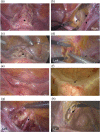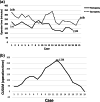Laparoscopic pectopexy: the learning curve and comparison with laparoscopic sacrocolpopexy
- PMID: 34406417
- PMCID: PMC9270277
- DOI: 10.1007/s00192-021-04934-4
Laparoscopic pectopexy: the learning curve and comparison with laparoscopic sacrocolpopexy
Abstract
Introduction and hypothesis: In addition to laparoscopic sacrocolpopexy (LS), laparoscopic pectopexy (LP) is a novel surgical method for correcting apical prolapse. The descended cervix or vaginal vault is suspended with a synthetic mesh by fixing the bilateral mesh ends to the pectineal ligaments. This study was aimed at developing a learning curve for LP and to compare it with results with LS.
Methods: We started laparoscopic/robotic pectopexy in our department in August 2019. This retrospective study included the initial 18 consecutive women with apical prolapse receiving LP and another group undergoing LS (21 cases) performed by the same surgeon. The medical and video records were reviewed.
Results: The age was older in the LP group than in the LS group (65.2 vs 53.1 years). The operation time of LP group was significantly shorter than that of the LS group (182.9 ± 27.2 vs 256.2 ± 45.5 min, p < 0.001). The turning point of the LP learning curve was observed at the 12th case. No major complications such as bladder, ureteral, bowel injury or uncontrolled bleeding occurred in either group. Postoperative low back pain and defecation symptoms occurred exclusively in the LS group. During the follow-up period (mean 7.2 months in LP, 16.2 months in LS), none of the cases had recurrent apical prolapse.
Conclusions: Laparoscopic pectopexy is a feasible surgical method for apical prolapse, with a shorter operation time and less postoperative discomfort than LS. LP may overcome the steep learning curve of LS because the surgical field of LP is limited to the anterior pelvis and avoids encountering the critical organs.
Keywords: Laparoscopy; Learning curve; Pectopexy; Pelvic organ prolapse; Sacrocolpopexy.
© 2021. The Author(s).
Conflict of interest statement
None.
Figures



Comment in
-
Letter to the Editor about "Laparoscopic pectopexy: the learning curve and comparison with laparoscopic sacrocolpopexy".Int Urogynecol J. 2022 Sep;33(9):2597-2598. doi: 10.1007/s00192-022-05303-5. Epub 2022 Jul 27. Int Urogynecol J. 2022. PMID: 35895132 No abstract available.
References
MeSH terms
LinkOut - more resources
Full Text Sources
Medical

